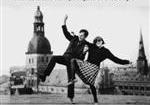|
|
 Also Waiting for Godot Also Waiting for Godot Jānis Borgs, Art Critic Book Nenocenzētie. Alternatīvā kultūra Latvijā: XX gs. 60-tie un 70-tie gadi ('The Unclassifiables. Alternative Culture in Latvia in the 1960-70s.'). Compiled by Eižens Valpēters (Riga, 2010) | |
| They could be looked upon variously. But definitely to be placed under the flag of opposition and protest. They are represented by the young intellectuals of the 1960s, the crowd that hung out at the cafes ‘Kaza’, ‘Dieva auss’, ‘Putnu dārzs’, the bitņiki, hippies and all kinds of other groups. What they all had in common was a deep spiritual hunger and dissatisfaction with the ruling Soviet regime, as well as a slightly idealized orientation towards the values of Western culture… There forms of opposition were many and varied, each of a markedly different character. There were the former legionnaires who had put down their schmeissers some time ago and the ‘forest brothers’ [the Resistance], of whom the ones who had survived had only recently returned from the gulags. They became the quietest protesters of all, as the overwhelming powers that be drove them into the position of losers. There were also the demonstrative risktaking rebels, who in the darkness of night hung out the red-white-red flag, or at least lit a candle by the tomb of Jānis Čakste. Relentless in defying the authorities, later they might have helped form, for instance, the Helsinki Group. They usually asked for trouble, and had plenty of it too. There was also a national “constructive” opposition – the berklavieši [followers of Eduards Berklavs] and a part of the Latvian intelligentsia, who joined the Communist Party with a hidden agenda to have some say, more or less, over their own land, because otherwise their place would be taken by cynical foreigners. They were constantly chased and pressured by the Moscow authorities and the bureaucracy of the party ideologues, and occasionally they were hated by the local purists too. But they, for their part, were successfully hiding behind the armour of red demagogy. It seems that exactly this opposition group deserves the greatest merit in inciting the National Awakening movement. And, finally, there were the young intellectuals, whose chief guiding principle perhaps was NOT TO PARTICIPATE, to be in a state of internal exile, to subsist in a world of their own ideals, in their own “abroad”… In the empire of totalitarianism, censorship and informers, any kind of free-thinking was unacceptable. That’s why the ability of this intellectual resistance to break loose from the gravitational force of the general censorship and to be free at least internally can be characterized as heroic. This is the environment which eventually produced a by no means small number of prominent intellectuals and persons of distinction. In contrast to the all the groups of opposition mentioned previously, which have been thoroughly and scientifically researched, so far there has been only the scantiest and most fragmentary information about this latter group. Now this gap in the Latvia’s cultural history has been filled by a book containing fundamental and surprisingly abundant information. Published by ‘Latvijas Vēstnesis’, the book is a collection of articles and other materials compiled by Eižens Valpēteris (in cooperation with Amanda Aizpuriete), under the title ‘The Unclassifiables. Alternative Culture in Latvia in the 1960-70s.’ Its 316 pages contain twenty articles characterizing the age and describing the alternative cultures, as well as many memoirs and artistic essays by contemporaries, hundreds of photographs, drawings and documents, a list of events and a bibliography… Considering the vast amount of material gathered and published, this work could well be described as titanic. It is one of those huge achievements where it can be felt that the ‘conductor’ of the work – Eižens Valpēteris – has selflessly invested his whole life. ‘Uncensored’ is a testimony to the will of one individual and a noble monument to his generation. In his ‘The Unclassifiables’ orchestra Valpēteris has succeeded in concentrating and joining into a many-voiced choir the fascinating and interesting writings of the ‘soloists’. Each of them has had their own experience and made some contribution to the “alternative” culture which was outside Soviet influence. The thick square volume has the attractive and non-academic format of a family album or household diary (design by Modris Brasliņš). It lures one to leaf through the pages, back and forth, to re-read the information and to rediscover new and previously unnoticed aspects of that odd age. All of the authors have truly managed to achieve the magical effect of travelling back in time and providing historic authenticity. In any case, the gourmets of Latvian culture have received a multi-layered dessert with the tiramisu allure and yearning of the nostalgia of youth, with a filling of berries of information, the fresh peppermint of conclusions and the bitter cinnamon of memories. ‘The Unclassifiables’ shows and confirms once again that each age has its own theatre of the absurd, and its own share of people who are waiting for Godot. /Translator into English: Vita Limanoviča/ | |
| go back | |







